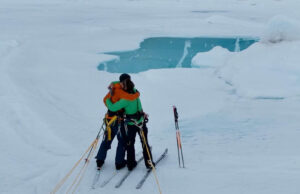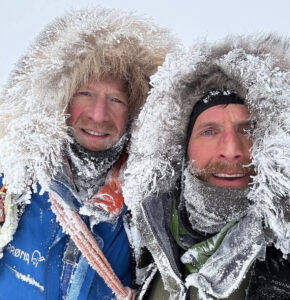The first time I realized that your circulation is highly sensitive at polar temperatures was on my first expedition, in Canada’s northern Labrador. It was too cold to stop for lunch, so I held my sandwich in my hand as I skied along, taking occasional bites. By the time I finished eating, I’d frostbitten my index finger, which had lightly held the sandwich.
It was the first and only case of frostbite I’ve ever had. It wasn’t a bad case: a big, purple, water-filled blister that hurt like hell, but which healed over the weeks as I continued.
It taught me a valuable lesson: Polar temperatures are not just colder than ordinary winter temperatures. They’re on a different spectrum: Gear, bodies react differently. It’s like being an astronaut on another planet.
I’m not talking about -20˚C. That’s cold enough, but things behave the same as you’re used to. At -40˚, -50˚, they don’t always.

Photo: Jerry Kobalenko
Numbness
The second lesson about hypersensitive circulation came years later, when one foot went numb. It did not feel like a dangerous numbness, a frostbite numbness. It felt, as sometimes happens on very cold expeditions, that the peripheral nerves had died. That occurs, usually on the feet, when the skin temperature is around 10˚C for long periods. The nerves near the surface die, and it takes a few weeks or months for them to grow back.
The numbness is a little concerning when it first happens, but it’s no big deal. Back home, feeling gradually returns. Numbness becomes tingling, and soon enough, the feet are fine again.
But that wasn’t the problem this time. I wondered why the other foot wasn’t numb too, so after a couple of days, I checked the problem foot in the tent. It looked fine, although my sock had come down a little and had bunched around the ankle. That little bunching had restricted circulation enough to cause numbness. How do I know? Because a day after I had pulled the sock back up, the feeling returned.

Bob Cochran switches into camp socks at the end of a travel day. Photo: Jerry Kobalenko
Diabetic socks
Such experiences have made me obsessive about avoiding even normally benign tightness, anywhere. On very cold expeditions, I wear midweight diabetic socks, because those medical socks stay up but do not constrict at all. Some ordinary socks are fine too, but others are too tight at the top.
Most very warm gloves are designed for downhill skiing. Downhill skiers do not ski at -40˚. And here in the Rockies, skiers love to crash through powder. So powder cuffs are useful for them. Not so for those pulling a sled in the polar regions. Sledders do not crash through powder. And those elastic cuffs pinch the wrist slightly and could affect your hands in those weird, wonderful polar temperatures.
So the first thing I do with a new pair of gloves for polar use is to remove the elastic powder cuff with a seam ripper. Sometimes I have to cut open the inside of the glove because the elastic is on the inside. It’s a bit finicky, but not hard.
Wristlets

Photo: Jerry Kobalenko
You might think that cold air might leak in through the now-wider mouth of the gloves. Not so, because you should always wear a pair of homemade wool or fleece wristlets if one of your undergarments does not already incorporate them.
The wristlets are thin enough that they do not constrict, and they add about half a layer of warmth. They let you make repairs in the tent barehanded or with just thin gloves on if it’s not too cold.






